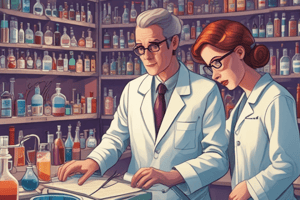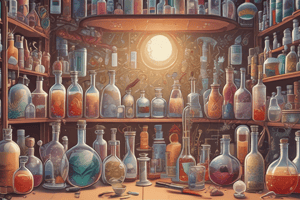Podcast
Questions and Answers
Before starting antibiotic treatment, what is the ideal time to obtain a 'good quality' clinical specimen?
Before starting antibiotic treatment, what is the ideal time to obtain a 'good quality' clinical specimen?
- After the first dose of antibiotics
- It does not matter as antibiotics do not affect specimen quality
- At the same time as administering antibiotics
- Before the start of antibiotics (correct)
What is the primary reason for using sterile containers when collecting microbiological specimens?
What is the primary reason for using sterile containers when collecting microbiological specimens?
- To avoid contamination of the specimen (correct)
- To reduce the cost of testing
- To ensure easy labeling
- To accelerate microbial growth
Why is prompt delivery of specimens to the laboratory critical?
Why is prompt delivery of specimens to the laboratory critical?
- To comply with legal requirements
- To reduce workload in the lab
- To avoid degradation of delicate pathogens (correct)
- To prevent delayed billing
What type of specimen is typically collected when pharyngitis is suspected?
What type of specimen is typically collected when pharyngitis is suspected?
In which of the following scenarios is collecting a sputum specimen most appropriate?
In which of the following scenarios is collecting a sputum specimen most appropriate?
When collecting specimens, what does the term 'aseptic conditions' refer to?
When collecting specimens, what does the term 'aseptic conditions' refer to?
What should the patient be provided with, when they are required to collect specimen by themselves?
What should the patient be provided with, when they are required to collect specimen by themselves?
What information should be included on a laboratory request form for a specimen?
What information should be included on a laboratory request form for a specimen?
What is the primary reason for disinfecting the patient's skin with 70% alcohol before drawing blood for culture?
What is the primary reason for disinfecting the patient's skin with 70% alcohol before drawing blood for culture?
Why is it important to avoid touching the disinfected skin site again after cleaning it for a blood culture?
Why is it important to avoid touching the disinfected skin site again after cleaning it for a blood culture?
When is aspiration using a sterile needle and syringe the preferred method for collecting specimens from the skin?
When is aspiration using a sterile needle and syringe the preferred method for collecting specimens from the skin?
What is the recommended method for collecting cerebrospinal fluid (CSF) when meningitis is suspected?
What is the recommended method for collecting cerebrospinal fluid (CSF) when meningitis is suspected?
Which urine sample collection method is typically recommended for most common urine analyses?
Which urine sample collection method is typically recommended for most common urine analyses?
How should the port of an indwelling catheter be cleaned before aspirating urine?
How should the port of an indwelling catheter be cleaned before aspirating urine?
If a urine specimen cannot be immediately tested in the lab, what is the appropriate action to preserve it?
If a urine specimen cannot be immediately tested in the lab, what is the appropriate action to preserve it?
Why are standard (universal) precautions necessary when handling all clinical specimens?
Why are standard (universal) precautions necessary when handling all clinical specimens?
What is the significance of collecting sputum specimens in the early morning for suspected tuberculosis (TB)?
What is the significance of collecting sputum specimens in the early morning for suspected tuberculosis (TB)?
In cases where a stool specimen is difficult to obtain from infants or children, what alternative is recommended?
In cases where a stool specimen is difficult to obtain from infants or children, what alternative is recommended?
What action is recommended for specimens that require transport to the lab, but the delivery is delayed?
What action is recommended for specimens that require transport to the lab, but the delivery is delayed?
Which of the following is a key reason for specimen rejection by the microbiology laboratory?
Which of the following is a key reason for specimen rejection by the microbiology laboratory?
Which of the following methods is appropriate for collecting urine from non-toilet-trained pediatric patients?
Which of the following methods is appropriate for collecting urine from non-toilet-trained pediatric patients?
For what reasons would a microbiology laboratory reject a specimen?
For what reasons would a microbiology laboratory reject a specimen?
What is the ideal specimen collection method, when middle ear infection is suspected?
What is the ideal specimen collection method, when middle ear infection is suspected?
What is the term used to describe the preferred collection time of urine specimens?
What is the term used to describe the preferred collection time of urine specimens?
Before an arterial puncture, what steps might increase the chances of obtaining a suitable specimen?
Before an arterial puncture, what steps might increase the chances of obtaining a suitable specimen?
What is the rationale behind using transport media for certain specimens with delayed delivery to the laboratory?
What is the rationale behind using transport media for certain specimens with delayed delivery to the laboratory?
Which action compromises the sterility of a blood culture collection?
Which action compromises the sterility of a blood culture collection?
What is the most appropriate protocol for collecting a urine sample from an older child who is toilet-trained?
What is the most appropriate protocol for collecting a urine sample from an older child who is toilet-trained?
Which scenario necessitates collecting two sets of blood cultures from different venipuncture sites?
Which scenario necessitates collecting two sets of blood cultures from different venipuncture sites?
Which practice should be stringently avoided when managing needles and syringes following blood culture collection?
Which practice should be stringently avoided when managing needles and syringes following blood culture collection?
A physician suspects a patient has a deep tissue infection. Which method is MOST suitable for collecting a specimen for culture?
A physician suspects a patient has a deep tissue infection. Which method is MOST suitable for collecting a specimen for culture?
What is the primary reason why CSF specimens should NOT be refrigerated after collection?
What is the primary reason why CSF specimens should NOT be refrigerated after collection?
A microbiology lab receives two urine specimens from the same patient. Specimen A was collected in the midstream using sterile technique, but transported at room temperature and delivered to the lab 3 hours after collection. Specimen B was collected via catheterization and immediately refrigerated, arriving at the lab 1 hour post-collection. Which specimen will the lab likely process, and why?
A microbiology lab receives two urine specimens from the same patient. Specimen A was collected in the midstream using sterile technique, but transported at room temperature and delivered to the lab 3 hours after collection. Specimen B was collected via catheterization and immediately refrigerated, arriving at the lab 1 hour post-collection. Which specimen will the lab likely process, and why?
A child’s physician suspects bacterial pneumonia. The child is able to expectorate a sputum sample, but it appears to be mostly saliva. What is the MOST appropriate course of action?
A child’s physician suspects bacterial pneumonia. The child is able to expectorate a sputum sample, but it appears to be mostly saliva. What is the MOST appropriate course of action?
Which factor justifies the collection of multiple stool specimens over several days when testing for suspected parasitic infections, such as Giardia lamblia or Entamoeba histolytica?
Which factor justifies the collection of multiple stool specimens over several days when testing for suspected parasitic infections, such as Giardia lamblia or Entamoeba histolytica?
What information on a laboratory request form is MOST critical for a microbiology lab to accurately process a blood culture?
What information on a laboratory request form is MOST critical for a microbiology lab to accurately process a blood culture?
A patient undergoing a lumbar puncture experiences severe pain during the procedure. Post-procedure, there is leakage of fluid from the puncture site. What action would be BEST to mitigate further complications?
A patient undergoing a lumbar puncture experiences severe pain during the procedure. Post-procedure, there is leakage of fluid from the puncture site. What action would be BEST to mitigate further complications?
Flashcards
Specimen classification
Specimen classification
Classify different types of specimens.
Proper specimen techniques
Proper specimen techniques
Recognize proper techniques for specimen collection and transport.
Specimen rejection criteria
Specimen rejection criteria
Identify criteria for specimen rejection by the microbiology laboratory.
Infection control in specimen collection
Infection control in specimen collection
Signup and view all the flashcards
Direct Method
Direct Method
Signup and view all the flashcards
Indirect Method
Indirect Method
Signup and view all the flashcards
Microscopic examination
Microscopic examination
Signup and view all the flashcards
Culture technique
Culture technique
Signup and view all the flashcards
Antigen detection (serology)
Antigen detection (serology)
Signup and view all the flashcards
Nucleic acid detection (PCR)
Nucleic acid detection (PCR)
Signup and view all the flashcards
Good Quality Specimen
Good Quality Specimen
Signup and view all the flashcards
Proper Selection
Proper Selection
Signup and view all the flashcards
Proper Collection
Proper Collection
Signup and view all the flashcards
Proper Transport
Proper Transport
Signup and view all the flashcards
Aspiration
Aspiration
Signup and view all the flashcards
Swabbing
Swabbing
Signup and view all the flashcards
Sputum
Sputum
Signup and view all the flashcards
Cerebrospinal fluid (CSF)
Cerebrospinal fluid (CSF)
Signup and view all the flashcards
Urine
Urine
Signup and view all the flashcards
Ear's Specimens
Ear's Specimens
Signup and view all the flashcards
Blood
Blood
Signup and view all the flashcards
Bacteremia
Bacteremia
Signup and view all the flashcards
Blood culture
Blood culture
Signup and view all the flashcards
Collecting Blood for Culture
Collecting Blood for Culture
Signup and view all the flashcards
Collecting Blood
Collecting Blood
Signup and view all the flashcards
Skin specimen collection
Skin specimen collection
Signup and view all the flashcards
Eyes and ears specimens
Eyes and ears specimens
Signup and view all the flashcards
Sputum
Sputum
Signup and view all the flashcards
CST
CST
Signup and view all the flashcards
Urine sample container
Urine sample container
Signup and view all the flashcards
Indwelling Catheter
Indwelling Catheter
Signup and view all the flashcards
Pediatric patients
Pediatric patients
Signup and view all the flashcards
Pediatric protocols
Pediatric protocols
Signup and view all the flashcards
Urine transport time
Urine transport time
Signup and view all the flashcards
Stool samples
Stool samples
Signup and view all the flashcards
Best results
Best results
Signup and view all the flashcards
Specimen transport
Specimen transport
Signup and view all the flashcards
Specimen rejection
Specimen rejection
Signup and view all the flashcards
Study Notes
- The lecture covers specimen collection and transport with the goal of enabling students to classify specimens, recognize proper collection and transport techniques, identify rejection criteria, and understand infection prevention.
Diagnosis of Bacterial Infections
- Direct methods involve examining the specimen, while indirect methods involve serological tests to detect antibodies.
Specimen Quality
- A 'good quality' clinical specimen is crucial for accurate infection diagnosis.
Obtaining Quality Specimens
- Collect specimens before starting antibiotics when possible.
- Choose specimens that represent the actual infection site.
- Use sterile containers for microbiological specimens.
- Avoid specimen contamination during collection.
- Transport specimens promptly to the lab, using transport media if necessary.
Proper Specimen Selection
- Selection should be based on the suspected infectious disease; e.g., throat swab for pharyngitis, sputum for pneumonia, cerebrospinal fluid (CSF) for meningitis, urine for UTIs, and stool for diarrhea.
Proper Collection Techniques
- Identify the necessary number, volume, and collection time of specimens.
- Collect specimens during the acute phase of infection.
- Maintain strict aseptic conditions to minimize contamination.
- Obtain the specimen before starting antibiotic therapy if feasible.
- Provide clear instructions to patients who collect their own specimens (e.g., sputum or urine).
- Use sterile specimen containers (except for stool), properly labeled, and accompanied by a lab request.
Lab Request Form Details
- Requests should include patient name, age, sex, location (department, ward, room number), physician's name, specimen type, collection date and time, clinical diagnosis, and antimicrobial therapy details.
Methods of Sample Collection
- Samples are collected through aspiration (pus, blood for blood culture), swabbing (throat swab), endoscopic specimens (bronchoalveolar lavage, gastric biopsy), or surgical specimens.
Specimen Types
- Examples of specimens include swabs, stool samples, universal containers, sterile containers, blood tubes and blood culture bottles.
Blood Culture
- Blood is normally sterile, bacteremia is the presence of bacteria in the bloodstream, and septicemia signifies bacteria and/or toxins in the bloodstream.
- A blood culture is performed to diagnose bacteremia.
Collecting Blood for Culture
- Standard precautions must be applied because blood-borne viruses such as hepatitis B, hepatitis C, and HIV may be transmitted.
- Perform hand hygiene, wear gloves, and use aseptic techniques.
- Disinfect the patient's skin with 70% alcohol (± betadine) in a concentric swabbing motion, allowing it to air dry.
- Do not touch the disinfected skin site again.
- Always disinfect the tops of blood culture bottles with 70% alcohol.
- Usually obtain 10 ml of blood for adults and 3-5 ml for children, injecting it immediately into the labeled and incubated blood culture bottle.
- Collect two sets of blood cultures from two different veins and do not recap syringes and needles and dispose of them in a safety box.
Skin Specimens
- Collect pus from abscesses by aspirating with a sterile needle and syringe after decontaminating the skin.
- Wounds are sampled best with a sterile needle and syringe or a sterile swab.
Eye and Ear Specimen Collection
- Use separate sterile swabs to sample the conjunctiva of both eyes, even if only one eye is infected.
- For otitis media, the ideal specimen is fluid aspirated from behind the ear drum with a sterile needle and syringe; using a sterile swab is not recommended unless the eardrum has ruptured.
- Eye and ear specimens should never be refrigerated.
Respiratory Specimens
- Specimens from the Upper Respiratory Tract Infections include throat and nasal swabs, nasopharyngeal swabs and washes.
- Sputum is the pus that accumulates in the lungs of a patient with pneumonia.
- Sputum specimens are collected preferably in the early morning and sputum, not saliva, needs to be collected.
- If tuberculosis (TB) is suspected, up to 3 morning sputum specimens are required.
- Other LRT specimens include Bronchoalveolar lavage; BAL
Central Nervous System (CNS) Infections
- Collect CSF specimen through lumbar puncture in cases of meningitis.
- The procedure must be performed under strict aseptic conditions by a physician.
- CSF specimens must be rapidly transported without refrigeration to maintain viability.
Urine Collection
- A midstream urine sample is most common.
- Use sterile, dry, wide-necked, leak-proof containers.
Obtaining Midstream Urine Sample
- Wash hands.
- Cleanse the area around the urethral opening with clean water.
- Dry the area with a sterile gauze pad.
- Collect the sample from the middle of the urine flow.
Indwelling Catheter Urine Collection
- Clean the port vigorously with 70% alcohol; aspirate urine with a sterile needle and syringe.
- Do not collect urine from the collection bag.
Pediatric Urine Collection
- Toilet-trained older children are instructed to collect a midstream urine sample, whereas, samples are collected by a sterile pediatric urine collector bag for non-toilet-trained children.
- If previous methods are not possible, a suprapubic needle aspiration or urinary catheter is used.
General Urine Specimen Guidelines
- Urine specimens are collected in the early morning.
- The lab only accepts a urine specimen that is held at room temperature for less than 2 hours or refrigerated for less than 24 hours.
Stool Specimen and Rectal Swab Specimens
- Diarrheal stool or rectal swabs are used with infants and children where obtaining stool is difficult.
Number of Specimens
- Collect at least 2 sets of blood cultures in 24 hours.
- 3 successive morning sputum samples for TB.
- Perform Paired sera (2 serum samples 1-2 weeks apart) for serological investigations to detect rising antibody titer.
Proper Transport
- Specimens should be delivered to the lab as soon as possible.
- If delivery is delayed, use a transport medium to prevent pathogen death.
- Place some specimens on ice during delivery, whereas others should never be refrigerated.
- Consider all clinical specimens as potential biohazards.
- Universal precautions must be taken.
Specimen Rejection Criteria
- Specimens without proper patient identification.
- Specimens received in poor condition (e.g., dry swab or leaking container).
- Prolonged transport times such as with urine samples held at room temperature for >2 hours.
- Specimens received in formalin for microbiological testing.
Studying That Suits You
Use AI to generate personalized quizzes and flashcards to suit your learning preferences.





